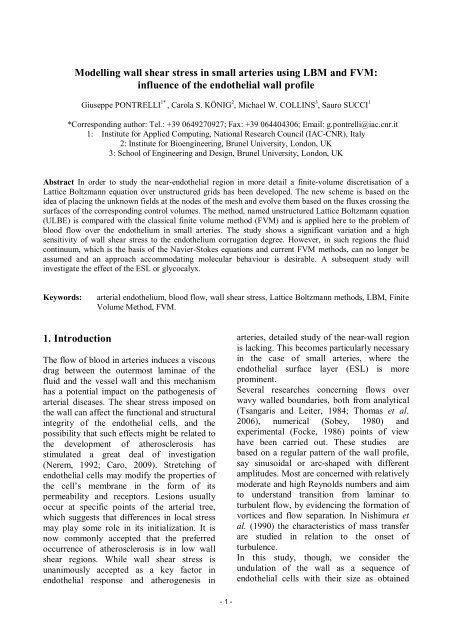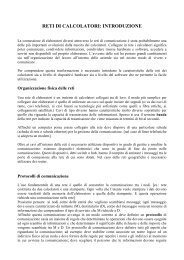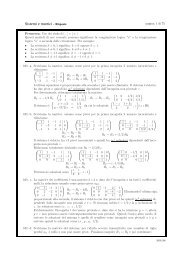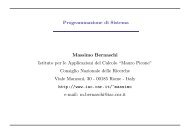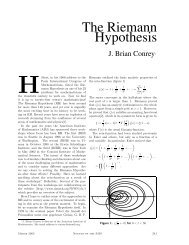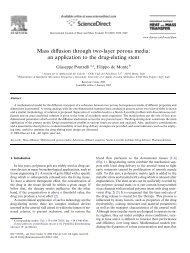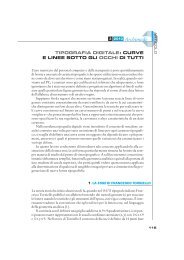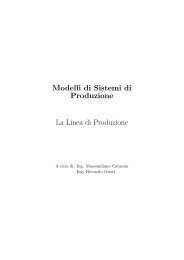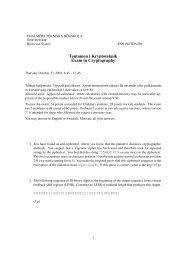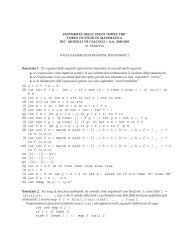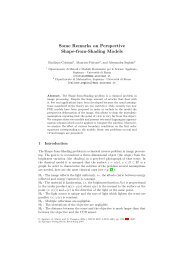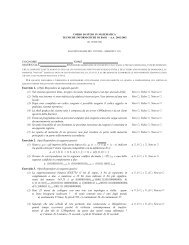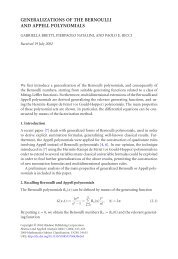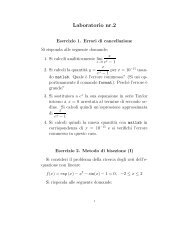Modelling wall shear stress in small arteries using LBM and FVM - Cnr
Modelling wall shear stress in small arteries using LBM and FVM - Cnr
Modelling wall shear stress in small arteries using LBM and FVM - Cnr
Create successful ePaper yourself
Turn your PDF publications into a flip-book with our unique Google optimized e-Paper software.
<strong>Modell<strong>in</strong>g</strong> <strong>wall</strong> <strong>shear</strong> <strong>stress</strong> <strong>in</strong> <strong>small</strong> <strong>arteries</strong> us<strong>in</strong>g <strong>LBM</strong> <strong>and</strong> <strong>FVM</strong>:<br />
<strong>in</strong>fluence of the endothelial <strong>wall</strong> profile<br />
Giuseppe PONTRELLI 1* , Carola S. KÖNIG 2 , Michael W. COLLINS 3 , Sauro SUCCI 1<br />
*Correspond<strong>in</strong>g author: Tel.: +39 0649270927; Fax: +39 064404306; Email: g.pontrelli@iac.cnr.it<br />
1: Institute for Applied Comput<strong>in</strong>g, National Research Council (IAC-CNR), Italy<br />
2: Institute for Bioeng<strong>in</strong>eer<strong>in</strong>g, Brunel University, London, UK<br />
3: School of Eng<strong>in</strong>eer<strong>in</strong>g <strong>and</strong> Design, Brunel University, London, UK<br />
Abstract In order to study the near-endothelial region <strong>in</strong> more detail a f<strong>in</strong>ite-volume discretisation of a<br />
Lattice Boltzmann equation over unstructured grids has been developed. The new scheme is based on the<br />
idea of plac<strong>in</strong>g the unknown fields at the nodes of the mesh <strong>and</strong> evolve them based on the fluxes cross<strong>in</strong>g the<br />
surfaces of the correspond<strong>in</strong>g control volumes. The method, named unstructured Lattice Boltzmann equation<br />
(ULBE) is compared with the classical f<strong>in</strong>ite volume method (<strong>FVM</strong>) <strong>and</strong> is applied here to the problem of<br />
blood flow over the endothelium <strong>in</strong> <strong>small</strong> <strong>arteries</strong>. The study shows a significant variation <strong>and</strong> a high<br />
sensitivity of <strong>wall</strong> <strong>shear</strong> <strong>stress</strong> to the endothelium corrugation degree. However, <strong>in</strong> such regions the fluid<br />
cont<strong>in</strong>uum, which is the basis of the Navier-Stokes equations <strong>and</strong> current <strong>FVM</strong> methods, can no longer be<br />
assumed <strong>and</strong> an approach accommodat<strong>in</strong>g molecular behaviour is desirable. A subsequent study will<br />
<strong>in</strong>vestigate the effect of the ESL or glycocalyx.<br />
Keywords:<br />
arterial endothelium, blood flow, <strong>wall</strong> <strong>shear</strong> <strong>stress</strong>, Lattice Boltzmann methods, <strong>LBM</strong>, F<strong>in</strong>ite<br />
Volume Method, <strong>FVM</strong>.<br />
1. Introduction<br />
The flow of blood <strong>in</strong> <strong>arteries</strong> <strong>in</strong>duces a viscous<br />
drag between the outermost lam<strong>in</strong>ae of the<br />
fluid <strong>and</strong> the vessel <strong>wall</strong> <strong>and</strong> this mechanism<br />
has a potential impact on the pathogenesis of<br />
arterial diseases. The <strong>shear</strong> <strong>stress</strong> imposed on<br />
the <strong>wall</strong> can affect the functional <strong>and</strong> structural<br />
<strong>in</strong>tegrity of the endothelial cells, <strong>and</strong> the<br />
possibility that such effects might be related to<br />
the development of atherosclerosis has<br />
stimulated a great deal of <strong>in</strong>vestigation<br />
(Nerem, 1992; Caro, 2009). Stretch<strong>in</strong>g of<br />
endothelial cells may modify the properties of<br />
the cell’s membrane <strong>in</strong> the form of its<br />
permeability <strong>and</strong> receptors. Lesions usually<br />
occur at specific po<strong>in</strong>ts of the arterial tree,<br />
which suggests that differences <strong>in</strong> local <strong>stress</strong><br />
may play some role <strong>in</strong> its <strong>in</strong>itialization. It is<br />
now commonly accepted that the preferred<br />
occurrence of atherosclerosis is <strong>in</strong> low <strong>wall</strong><br />
<strong>shear</strong> regions. While <strong>wall</strong> <strong>shear</strong> <strong>stress</strong> is<br />
unanimously accepted as a key factor <strong>in</strong><br />
endothelial response <strong>and</strong> atherogenesis <strong>in</strong><br />
<strong>arteries</strong>, detailed study of the near-<strong>wall</strong> region<br />
is lack<strong>in</strong>g. This becomes particularly necessary<br />
<strong>in</strong> the case of <strong>small</strong> <strong>arteries</strong>, where the<br />
endothelial surface layer (ESL) is more<br />
prom<strong>in</strong>ent.<br />
Several researches concern<strong>in</strong>g flows over<br />
wavy <strong>wall</strong>ed boundaries, both from analytical<br />
(Tsangaris <strong>and</strong> Leiter, 1984; Thomas et al.<br />
2006), numerical (Sobey, 1980) <strong>and</strong><br />
experimental (Focke, 1986) po<strong>in</strong>ts of view<br />
have been carried out. These studies are<br />
based on a regular pattern of the <strong>wall</strong> profile,<br />
say s<strong>in</strong>usoidal or arc-shaped with different<br />
amplitudes. Most are concerned with relatively<br />
moderate <strong>and</strong> high Reynolds numbers <strong>and</strong> aim<br />
to underst<strong>and</strong> transition from lam<strong>in</strong>ar to<br />
turbulent flow, by evidenc<strong>in</strong>g the formation of<br />
vortices <strong>and</strong> flow separation. In Nishimura et<br />
al. (1990) the characteristics of mass transfer<br />
are studied <strong>in</strong> relation to the onset of<br />
turbulence.<br />
In this study, though, we consider the<br />
undulation of the <strong>wall</strong> as a sequence of<br />
endothelial cells with their size as obta<strong>in</strong>ed<br />
- 1 -
from the literature (Fig. 1). Only recently it has<br />
been recognized that the endothelial<br />
glycocalyx may contribute to the protection of<br />
the vascular <strong>wall</strong> <strong>in</strong> <strong>small</strong> vessels aga<strong>in</strong>st<br />
disease by reduc<strong>in</strong>g friction to the flow of<br />
blood <strong>and</strong> serv<strong>in</strong>g as a barrier for loss of fluid<br />
through the vessel <strong>wall</strong>. Particularly <strong>in</strong> times<br />
of <strong>in</strong>flammation though, the endothelial<br />
glycocalyx is <strong>shear</strong>ed off, to permit attachment<br />
of leukocytes <strong>and</strong> movement of water from<br />
microvessels result<strong>in</strong>g <strong>in</strong> the exposure of the<br />
wavy endothelium (We<strong>in</strong>baum et al., 2003). In<br />
this work, however, only mechanical effects<br />
are considered, while all chemical <strong>and</strong><br />
biological processes of the endothelium are<br />
neglected. The hemodynamic problem is<br />
solved by us<strong>in</strong>g a Lattice Boltzmann (LB)<br />
approach (Succi, 2001). The ma<strong>in</strong> advantages<br />
of LB are its simplicity <strong>and</strong> amenability to<br />
parallel comput<strong>in</strong>g. In particular, ow<strong>in</strong>g to its<br />
k<strong>in</strong>etic nature, the pressure field <strong>and</strong> the <strong>stress</strong><br />
tensor are locally available, without the need<br />
of solv<strong>in</strong>g any (usually expensive) Poisson<br />
problem.<br />
non-localities are l<strong>in</strong>ear because advection<br />
proceeds along constant, straight l<strong>in</strong>es def<strong>in</strong>ed<br />
by the discrete speeds. This is a very useful<br />
property, not shared by the Navier-Stokes<br />
equations, <strong>in</strong> which non-l<strong>in</strong>earity <strong>and</strong> nonlocality<br />
come together <strong>in</strong>to the same<br />
convective term, that is, the fluid moves its<br />
own momentum along a space-time chang<strong>in</strong>g<br />
direction def<strong>in</strong>ed by the flow speed itself.<br />
However, a recognized weakness of LB is its<br />
restriction to regular, uniform lattices<br />
(Cartesian grids). This limitation is particularly<br />
severe whenever high local resolution is<br />
required, as is the case for most flows of<br />
biomedical <strong>in</strong>terest. For <strong>in</strong>stance, curved<br />
boundaries must be approximated by staircase<br />
profiles aligned with the gridl<strong>in</strong>e coord<strong>in</strong>ates,<br />
an approximation which can lead to severe<br />
<strong>in</strong>accuracies, unless a sophisticated treatment<br />
of the boundary is devised or high grid<br />
resolution applied (Guo et al., 2002). The<br />
problem has motivated a wide body of<br />
research aimed at extend<strong>in</strong>g the LB method to<br />
non-uniform grids with boundary conditions<br />
capable of accommodat<strong>in</strong>g curved boundaries<br />
(Peng, 1998). Particularly <strong>in</strong>terest<strong>in</strong>g are<br />
recent attempts to formulate LB on fully<br />
unstructured grids us<strong>in</strong>g cell-vertex f<strong>in</strong>itevolume<br />
schemes (Ubert<strong>in</strong>i et al. 2002, 2004).<br />
2. Formulation of the problem<br />
Fig. 1: The rough surface of the endothelium (from<br />
Reichl<strong>in</strong> et al., 2005). Arrows po<strong>in</strong>t to granular<br />
structures on EC’s surface, white l<strong>in</strong>e marks<br />
scann<strong>in</strong>g l<strong>in</strong>e for height profile evaluation, scale<br />
bar corresponds to 5µm.<br />
Another key property of LB is that nonl<strong>in</strong>earities<br />
are local (quadratic dependence of<br />
the local equilibrium on the flow field) <strong>and</strong> the<br />
In most studies of haemodynamics, the arterial<br />
<strong>wall</strong> is generally assumed to be flat, <strong>and</strong> the<br />
wavy surface of the endothelium is neglected:<br />
this does not imply a significant variation <strong>in</strong><br />
the flow field, but it can be relevant <strong>in</strong><br />
comput<strong>in</strong>g WSS, which is constant <strong>in</strong> a flat<strong>wall</strong>ed<br />
artery. Indeed, the <strong>in</strong>ternal surface of<br />
the vessel <strong>wall</strong> is covered by endothelial cells<br />
that form a cont<strong>in</strong>uous, wavy layer. We<br />
assume that the endothelial cell membrane is<br />
solid-like, so the cells keep their shape while<br />
subjected to the <strong>shear</strong> <strong>stress</strong> due to the blood<br />
stream.<br />
An endothelial cell (EC) has been estimated to<br />
be about 15 m long by 0.5 m<br />
high (Reichl<strong>in</strong><br />
et al., 2005, see Fig. 1). We consider a twodimensional<br />
channel flow between two<br />
- 2 -
oundary surfaces located at y h( x)<br />
, with<br />
the x-axis <strong>in</strong> the direction of the flow. The<br />
shape of the each <strong>in</strong>ternal <strong>wall</strong> appears as a<br />
smoothly corrugated surface: the channel<br />
semi-width is obta<strong>in</strong>ed as a perturbation<br />
around a reference value H:<br />
<br />
h( x) H <br />
( x) H (1 ) with the<br />
H<br />
corrugation degree.<br />
Although the <strong>wall</strong> surface is constituted by an<br />
irregular (r<strong>and</strong>omly rough) sequence of EC's,<br />
for simplicity we assume that they are<br />
regularly l<strong>in</strong>ed <strong>and</strong> equally distributed over the<br />
top <strong>and</strong> the bottom <strong>wall</strong>s, <strong>and</strong> their size<br />
<strong>in</strong>dependent of the channel height H. For all H,<br />
the aspect ratio of the channel has been fixed<br />
at 3.<br />
The aim of this study is to <strong>in</strong>vestigate the<br />
dependence <strong>and</strong> the sensitivity of the WSS to<br />
the <strong>wall</strong> roughness, to the degree of<br />
corrugation <strong>and</strong> to quantify the WSS<br />
differences with the variation of vessel<br />
diameter or flow rates. Assum<strong>in</strong>g<br />
axisymmetry, we limit our study to a twodimensional<br />
straight channel, where a<br />
Newtonian fluid of viscosity μ <strong>and</strong> density ρ<br />
flows, be<strong>in</strong>g driven by a constant volumetric<br />
force. The fluid dynamics predictions are<br />
based on a steady flow, on the assumption that<br />
the mean flow <strong>in</strong> pulsatile conditions is similar<br />
to steady flow with the same time averaged<br />
velocity.<br />
3. Lattice Boltzmann methodology<br />
Let us consider the classical differential form<br />
of the s<strong>in</strong>gle-time relaxation Lattice<br />
Boltzmann equation:<br />
<br />
f c f ( f f eq ) / F<br />
t i i i i i i<br />
(1)<br />
The above equation models hydrodynamic<br />
fluid flow by track<strong>in</strong>g the time-evolution of<br />
the density distribution function of pseudoparticles<br />
(or populations), def<strong>in</strong>ed as<br />
fi<br />
( x , t) f ( x, v c <br />
i, t)<br />
, where f<br />
i<br />
is the<br />
probability of f<strong>in</strong>d<strong>in</strong>g a particle at site x , at<br />
time t mov<strong>in</strong>g along the lattice direction<br />
def<strong>in</strong>ed by the discrete speed c i<br />
. In eqn. (1) F i<br />
represents the effect of external/<strong>in</strong>ternal<br />
sources of mass/momentum/energy.<br />
The left-h<strong>and</strong> side of equation (1) represents<br />
the particle free-stream<strong>in</strong>g, whereas the righth<strong>and</strong><br />
side represents molecular collisions via a<br />
s<strong>in</strong>gle-time relaxation towards local<br />
equilibrium<br />
f on a typical timescale λ<br />
eq<br />
i<br />
(Benzi et al., 1992).<br />
The local equilibrium is the Maxwell-<br />
Boltzmann distribution function exp<strong>and</strong>ed<br />
second order <strong>in</strong> the local Mach number:<br />
2<br />
eq<br />
2 2<br />
<br />
fi wi 1 ui ( ui<br />
u )<br />
2<br />
(2)<br />
<br />
<br />
2<br />
where 1/ cs<br />
, be<strong>in</strong>g c<br />
s<br />
the lattice sound<br />
speed, f the fluid density,<br />
i<br />
i<br />
i<br />
<br />
u ci<br />
fi<br />
/ is the fluid speed <strong>and</strong><br />
wi<br />
are<br />
weight coefficients (normalized to unity)<br />
associated with zero-flow global equilibria.<br />
In the limit of weak departures from local<br />
equilibrium, i.e. <strong>small</strong> Knudsen numbers, it<br />
can be shown through a Chapman-Enskog<br />
analysis that the discrete LB recovers the<br />
dynamic behaviour of a fluid with pressure<br />
2<br />
p c s<br />
<strong>and</strong> k<strong>in</strong>ematic viscosity<br />
c<br />
2 s<br />
( k t)<br />
, where k is a numerical<br />
coefficient depend<strong>in</strong>g on the specific timemarch<strong>in</strong>g<br />
scheme (k=0 <strong>in</strong> the cont<strong>in</strong>uum time<br />
limit, <strong>and</strong> k=-1/2 for the st<strong>and</strong>ard lattice<br />
Boltzmann equation on uniform Cartesian<br />
grids) (Benzi et al, 1992).<br />
In order to recover the correct fluid dynamic<br />
equations <strong>in</strong> the macroscopic limit, the set of<br />
discrete speeds must satisfy mass, momentum<br />
<strong>and</strong> energy conservation, as well as rotational<br />
symmetry. It should be noted that only a<br />
limited class of lattices exhibits the right<br />
symmetry to ensure the conservation<br />
constra<strong>in</strong>ts. In the present work we shall refer<br />
to the two-dimensional n<strong>in</strong>e-speed model<br />
(known as D2Q9) def<strong>in</strong>ed by the follow<strong>in</strong>g set<br />
of discrete speeds:<br />
- 3 -
c0 (0,0), c1 (1,0), c2<br />
(0,1),<br />
<br />
c3 ( 1,0), c4 (0, 1), c5<br />
(1,1),<br />
<br />
c ( 1,1), c ( 1, 1), c (1, 1).<br />
6 7 8<br />
with weights w 0 = 4/9, w 1-4 = 1/9, w 5-8 = 1/36 <strong>in</strong><br />
eqn. (2). The aforementioned low-Mach<br />
number expansion restricts the use of the<br />
discrete Boltzmann equation to quasi<strong>in</strong>compressible<br />
flows, with negligible spacetime<br />
variation of the fluid density. On the<br />
other h<strong>and</strong>, s<strong>in</strong>ce the discrete LB fluid obeys<br />
an ideal equation of state, significant pressure<br />
drops can only be susta<strong>in</strong>ed by<br />
supplement<strong>in</strong>g/replac<strong>in</strong>g the pressure gradient<br />
with an external body force (force per unit<br />
volume) F .<br />
In a steady plane-channel flow, the magnitude<br />
of the body force is determ<strong>in</strong>ed by impos<strong>in</strong>g<br />
an exact balance with dissipative effects,<br />
i.e. F <br />
yyux<br />
. This delivers:<br />
2U<br />
max<br />
F .<br />
2<br />
H<br />
This approach is equivalent to assign a<br />
2U<br />
max<br />
pressure gradient G along the<br />
2<br />
H<br />
channel length. The effect of the body force on<br />
the discrete populations <strong>in</strong> eqn. (1) is given<br />
by:<br />
<br />
wi<br />
F ci<br />
Fi<br />
which f<strong>in</strong>ally results <strong>in</strong> the<br />
2<br />
cs<br />
follow<strong>in</strong>g forc<strong>in</strong>g term:<br />
2U<br />
max<br />
Fi<br />
(3)<br />
2<br />
H<br />
Boundary conditions are no-slip at top/bottom<br />
<strong>wall</strong>s <strong>and</strong> periodic at <strong>in</strong>let/outlet.<br />
4. LB over unstructured grids<br />
The presented st<strong>and</strong>ard LB method is<br />
macroscopically similar to a uniform<br />
Cartesian-grid solver, <strong>and</strong> this represents a<br />
severe limitation for solv<strong>in</strong>g complex<br />
geometries typical of haemodynamic flows. To<br />
overcome this drawback, the classical LB<br />
method has been extended to use irregular<br />
grids. This approach is based on a f<strong>in</strong>itevolume<br />
scheme of the cell-vertex type<br />
consist<strong>in</strong>g of a tessellation based on triangular<br />
elements. The use of unstructured grids with<br />
control volumes of arbitrary polygonal shape<br />
allows local grid ref<strong>in</strong>ements not possible with<br />
the st<strong>and</strong>ard LB. To solve eqn. (1), the n<strong>in</strong>e<br />
<br />
discrete populations fi<br />
( xt)<br />
associated to<br />
each node P of the discrete grid (Fig. 2)<br />
represent the unknowns of the problem. The<br />
f<strong>in</strong>ite volume over which eq. (1) is <strong>in</strong>tegrated<br />
is def<strong>in</strong>ed by means of the set of K triangles,<br />
which share P as a common vertex. S<strong>in</strong>ce<br />
the discrete grid is unstructured, each node is<br />
identified by its coord<strong>in</strong>ates <strong>and</strong> the<br />
connectivity ( P Pk<br />
Pk<br />
1) is free to change<br />
from node to node. As shown <strong>in</strong> Fig.2, the<br />
portion of the control volume<br />
k Ck Ek P Ek<br />
1<br />
that refers to the k-th<br />
triangular element is built through the union of<br />
<br />
the two sub-grid triangles [ P E C ]<br />
k k k<br />
<br />
<strong>and</strong> k [ PCk Ek<br />
1]<br />
, where C<br />
k<br />
is the<br />
centre of the grid element <strong>and</strong> E<br />
k<br />
<strong>and</strong> Ek<br />
1<br />
are the midpo<strong>in</strong>ts of the edges that share P<br />
as a common vertex. Populations at off-grid<br />
po<strong>in</strong>ts E<br />
k<br />
<strong>and</strong> C<br />
k<br />
are calculated with<br />
st<strong>and</strong>ard l<strong>in</strong>ear <strong>in</strong>terpolations. Application of<br />
the Gauss theorem to each f<strong>in</strong>ite volume<br />
portion yields the follow<strong>in</strong>g set of ord<strong>in</strong>ary<br />
differential equations:<br />
1<br />
t fi( Pt) ( ik ik<br />
) (4)<br />
VP<br />
k<br />
where the sum k 0 K runs over the control<br />
volume P k <br />
k<br />
obta<strong>in</strong>ed by jo<strong>in</strong><strong>in</strong>g the<br />
centres C<br />
k<br />
with edge midpo<strong>in</strong>ts E<br />
k<br />
, V<br />
P<br />
is<br />
the volume of <strong>and</strong> the <strong>in</strong>dex k 0<br />
P<br />
denotes the pivotal po<strong>in</strong>t P . F<strong>in</strong>ally, <br />
ik<br />
denote the fluxes associated with stream<strong>in</strong>g<br />
operator <strong>and</strong> <br />
ik<br />
the <strong>in</strong>tegral of the collision<br />
operators of the i -th population at the k -th<br />
node, respectively. The detailed expressions of<br />
the stream<strong>in</strong>g <strong>and</strong> collision matrices S <strong>and</strong><br />
C<br />
ik<br />
, give the follow<strong>in</strong>g general form of<br />
ik<br />
- 4 -
velocity variables. Appropriate scal<strong>in</strong>g was<br />
achieved by apply<strong>in</strong>g dimensional analysis <strong>in</strong><br />
order to achieve good convergence.<br />
6. Computational results<br />
Fig. 2: The cell-vertex f<strong>in</strong>ite-volume discretisation<br />
around a grid po<strong>in</strong>t P.<br />
the Unstructured Lattice Boltzmann Equation<br />
(ULBE):<br />
f ( Pt) S f ( P t)<br />
<br />
t i ik i k<br />
k0<br />
K<br />
<br />
K<br />
1<br />
eq<br />
Cik[ fi ( Pk t) fi ( Pk<br />
t)]<br />
k 0<br />
By def<strong>in</strong>ition the follow<strong>in</strong>g sum rules apply:<br />
K<br />
<br />
S 0<br />
C 1 i<br />
ik<br />
k 0 k 0<br />
It is readily checked that the <strong>stress</strong> tensor<br />
is related to the non-equilibrium<br />
component of the momentum flux tensor by<br />
the follow<strong>in</strong>g local expression:<br />
eq<br />
( fi<br />
fi<br />
) ci ci<br />
i<br />
where run over spatial dimensions.<br />
5. The F<strong>in</strong>ite Volume Method<br />
In the CFD calculations a st<strong>and</strong>ard <strong>FVM</strong> was<br />
applied. As <strong>in</strong> the <strong>LBM</strong> model the fluid flow<br />
was treated as steady, <strong>in</strong>compressible,<br />
isothermal <strong>and</strong> Newtonian. The govern<strong>in</strong>g<br />
equations (cont<strong>in</strong>uity <strong>and</strong> momentum<br />
equations) were solved on a 2D, nonorthogonal<br />
grid us<strong>in</strong>g the f<strong>in</strong>ite volume code<br />
Ansys-CFX4. The pressure was obta<strong>in</strong>ed us<strong>in</strong>g<br />
the SIMPLE algorithm. The differenc<strong>in</strong>g<br />
schemes used were central differenc<strong>in</strong>g for<br />
pressure <strong>and</strong> hybrid differenc<strong>in</strong>g for the<br />
K<br />
ik<br />
First of all, a benchmark test was <strong>in</strong>tended to<br />
assess the efficacy of the ULBE methodology<br />
on a flat-<strong>wall</strong>ed artery fully developed flow<br />
model.<br />
We considered a uniform unstructured<br />
automatically generated grid on a 2D channel<br />
[ 3 H ,3 H] [ H, H ] , consist<strong>in</strong>g of 5634<br />
equidistributed elements, <strong>and</strong> the simulations<br />
were performed for a wide range of Reynolds<br />
numbers. Comparison of ULBE solution with<br />
the Poiseuille velocity profile:<br />
2<br />
y <br />
u( y) U<br />
max 1<br />
2 <br />
(5)<br />
H <br />
5<br />
exhibit a maximum error E 10 , while the<br />
discrepancy with the <strong>wall</strong> <strong>shear</strong> <strong>stress</strong><br />
4 U<br />
max<br />
(6)<br />
D<br />
4<br />
results of E 10 .<br />
Typical values for arterioles (microcirculation)<br />
are:<br />
3<br />
1 g / cm =0.027 P<br />
D=25 150 m Umax<br />
1<br />
40 cm / s<br />
that comb<strong>in</strong>e <strong>in</strong> a range of<br />
DU<br />
max<br />
Re 0.110.<br />
Although these<br />
<br />
values can be larger than those perta<strong>in</strong><strong>in</strong>g to<br />
the arterioles, this numerical study is aimed to<br />
underst<strong>and</strong> the flow dependence on the<br />
geometrical-physical parameters on a wider<br />
range <strong>and</strong>, <strong>in</strong> particular, the sensitivity of the<br />
solution on the degree of corrugation ε <strong>and</strong> on<br />
the Reynolds number.<br />
- 5 -
Fig. 3: The scaled 2D arterial segment covered by<br />
a ref<strong>in</strong>ed triangular mesh.<br />
The COMSOL package was used to generate<br />
the grid, with a mesh ref<strong>in</strong>ement near the <strong>wall</strong><br />
to suit the wavy profile. For this case, the grid<br />
size ranges from 3830 (D=25) to 7960<br />
(D=150) triangular elements. The grid is<br />
ref<strong>in</strong>ed near the <strong>wall</strong> to suit the wavy<br />
endothelial surface (Fig. 3). The channel<br />
maximum semi-width is normalized to H=1.<br />
The time step t is chosen <strong>in</strong> relation to the<br />
<strong>small</strong>est grid size (which typically reduces as<br />
H <strong>in</strong>creases) <strong>in</strong> order to satisfy the CFL<br />
condition.<br />
At such <strong>small</strong> flow rates, the velocity profiles<br />
preserve the parabolic shape (Fig. 4), but the<br />
<strong>wall</strong> corrugation causes a local change of the<br />
velocity derivative <strong>and</strong> hence an oscillation on<br />
the WSS values. As a matter of fact, the <strong>stress</strong><br />
has a l<strong>in</strong>ear rise <strong>in</strong> the transversal direction,<br />
except near the <strong>wall</strong>, where the vary<strong>in</strong>g cross<br />
section width generates a substantial local<br />
difference <strong>in</strong> the <strong>shear</strong> rates <strong>and</strong> <strong>stress</strong>es.<br />
Figure 5 shows that the consequence is a local<br />
variation of these quantities <strong>in</strong> a boundary<br />
layer close to the <strong>wall</strong> <strong>and</strong> an oscillation of the<br />
<strong>shear</strong> rates <strong>and</strong> WSS along the endothelium.<br />
Fig. 5: Cross-stream variation of <strong>shear</strong> <strong>stress</strong>:<br />
Cont<strong>in</strong>uous l<strong>in</strong>e – peak of EC, dashed l<strong>in</strong>e – valley<br />
of EC (LB units).<br />
A l<strong>in</strong>ear ris<strong>in</strong>g of the <br />
with U is found,<br />
while an <strong>in</strong>versely l<strong>in</strong>ear dependence on D, as<br />
depicted <strong>in</strong> Fig. 6, describ<strong>in</strong>g essentially the<br />
trend of eqn. (6). A similar behaviour holds for<br />
<br />
. As a consequence, WSS oscillates between<br />
a m<strong>in</strong>imum <br />
<strong>and</strong> maximum <br />
values, which<br />
basically trace the undulation of the <strong>wall</strong>,<br />
where the m<strong>in</strong>imum <strong>and</strong> maximum of τ<br />
correspond to the maximum <strong>and</strong> m<strong>in</strong>imum<br />
diameters, respectively.<br />
Table 1: The ratio τ - /τ + at different velocities<br />
(cm/s) <strong>and</strong> diameters (µm). The correspond<strong>in</strong>g<br />
Reynolds numbers are bracketed.<br />
D=25 D=50 D=100 D=150<br />
U=1 0.55<br />
(0.09)<br />
0.54-0.55<br />
(0.18)<br />
0.55-0.56<br />
(0.37)<br />
0.55-0.57<br />
(0.55)<br />
U=20 0.55<br />
(1.85)<br />
0.54-0.55<br />
(3.7)<br />
0.55-0.56<br />
(7.4)<br />
0.55-0.57<br />
(11.11)<br />
U=40 0.55<br />
(3.7)<br />
0.54-0.55<br />
(7.4)<br />
0.55-0.56<br />
(14.81)<br />
0.55-0.57<br />
(22.22)<br />
Fig. 4: Parabolic velocity profiles (x 100) along the<br />
wavy-<strong>wall</strong>ed channel (U=40, D=50).<br />
- 6 -
Fig. 6: Variation of the maximum <strong>wall</strong> <strong>shear</strong> <strong>stress</strong><br />
profile for vary<strong>in</strong>g diameter for various maximum<br />
<strong>in</strong>let velocities (cm/s). Stars <strong>in</strong>dicate results from<br />
simulations, cont<strong>in</strong>uous l<strong>in</strong>es are fitt<strong>in</strong>g curves.<br />
Their values depends on the diameter <strong>and</strong> flow<br />
rate, but their ratio <br />
<br />
/ <br />
<br />
rema<strong>in</strong>s constant<br />
(Table 1). Some numerical ‘wiggles’ due to<br />
the grid discreteness are present <strong>in</strong> the WSS<br />
values. These m<strong>in</strong>or oscillations are found to<br />
rema<strong>in</strong> with<strong>in</strong> a few percentage <strong>and</strong> do not<br />
play any significant role on the overall<br />
physical picture.<br />
It is also recognized that the amplitude of the<br />
oscillat<strong>in</strong>g WSS can play a relevant role <strong>in</strong> the<br />
formation <strong>and</strong> development of atherosclerotic<br />
diseases. A further analysis is carried out <strong>in</strong><br />
this respect. In fig. 7, the l<strong>in</strong>ear trend of <br />
<strong>and</strong><br />
<br />
is shown. It is commonly accepted that<br />
critical <strong>wall</strong> <strong>shear</strong> <strong>stress</strong> levels may be those<br />
below 1Pa or above 4Pa (Atherton, 2009).<br />
Fig. 7:<br />
The l<strong>in</strong>ear rise of <br />
<strong>and</strong> <br />
with the<br />
corrugation degree <strong>in</strong> the case of U max = 1cm/s.<br />
The shaded area depicts the safe region for<br />
corrugation degree/WSS.<br />
Whereas <strong>FVM</strong> (König et al., 2006) produced a<br />
τ + of 0.618 Pa (compared to a τ* of 0.5184 Pa<br />
for straight <strong>wall</strong>s) for the D = 25 µm case with<br />
U <strong>in</strong> = 0.08 cm/s, the <strong>LBM</strong> method resulted <strong>in</strong> a<br />
τ + value of 4.864Pa, which puts both results<br />
just outside the optimal range from either end.<br />
However, this discrepancy is likely to be the<br />
result of the slightly different boundary<br />
conditions applied to the models. Whereas the<br />
<strong>FVM</strong> had a straight <strong>in</strong>let velocity profile with<br />
a long entry length <strong>and</strong> an array of 40 ECs, the<br />
<strong>LBM</strong> model used a parabolic profile on a<br />
much shorter EC array <strong>and</strong> periodic boundary<br />
conditions. However, the results agreed<br />
favourably when the τ - /τ + ratios were<br />
compared with the <strong>FVM</strong> ones be<strong>in</strong>g<br />
approximately 7 % lower.<br />
Tables 2-3 show the amplitude of the<br />
oscillation Δτ/2 =<br />
/ 2 <strong>and</strong> demonstrate<br />
<br />
the (almost) l<strong>in</strong>ear <strong>in</strong>creas<strong>in</strong>g with D. The ratio<br />
of the amplitude over the straight <strong>wall</strong> value τ*<br />
is nearly 25% <strong>in</strong> all cases. The results show a<br />
marked variation of with the diameter,<br />
which <strong>in</strong>creases for <strong>small</strong>er sized <strong>arteries</strong>.<br />
Although the <strong>wall</strong> corrugation does not<br />
<strong>in</strong>fluence the flow pattern notably, it <strong>in</strong>duces a<br />
large variation <strong>in</strong> τ.<br />
<br />
- 7 -
Table 2: The amplitude of oscillation of τ <strong>and</strong> its<br />
ratio to the correspond<strong>in</strong>g flat-<strong>wall</strong>ed value τ* at<br />
U max = 1 cm/s <strong>and</strong> at several diameters.<br />
D (µm) ε = δ/D Δτ /2 (dyne/cm 2 ) Δτ /τ*<br />
∞ 0 0 -<br />
150 0.0067 1.77 0.24<br />
100 0.01 2.72 0.25<br />
50 0.02 5.76 0.26<br />
25 0.04 11.52 0.26<br />
Table 3: The amplitude of oscillation of τ <strong>and</strong> its<br />
ratio to the correspond<strong>in</strong>g flat-<strong>wall</strong>ed value τ* at<br />
U max = 20 cm/s <strong>and</strong> at several diameters.<br />
D (µm) ε = δ/D Δτ /2 (dyne/cm 2 ) Δτ /τ*<br />
∞ 0 0 -<br />
150 0.0067 37.33 0.25<br />
100 0.01 55.2 0.25<br />
50 0.02 112 0.25<br />
25 0.04 217.6 0.25<br />
7. Towards study<strong>in</strong>g the glycocalyx:<br />
modell<strong>in</strong>g the endothelial surface<br />
layer over a wavy <strong>wall</strong><br />
The purpose of this paper is to <strong>in</strong>vestigate the<br />
effect of a more realistic endothelial surface<br />
geometry on the fluid dynamics, especially on<br />
<strong>wall</strong> <strong>shear</strong> <strong>stress</strong>. The results presented <strong>in</strong><br />
previous section are obta<strong>in</strong>ed under the<br />
assumption of a smooth <strong>and</strong> rigid <strong>wall</strong> surface.<br />
However, the endothelial surface is not only<br />
wavy <strong>in</strong> its geometry, but, at lower scale, it is<br />
covered by a ciliate layer called endothelial<br />
surface layer or glycocalyx. Chemically, this<br />
may be described as a coat<strong>in</strong>g of long cha<strong>in</strong><br />
macromolecules <strong>and</strong> prote<strong>in</strong>s that form a<br />
th<strong>in</strong> porous layer (We<strong>in</strong>baum et al., 2007). The<br />
<strong>in</strong>dividual cells are <strong>in</strong>dividually del<strong>in</strong>eated,<br />
be<strong>in</strong>g separated from each other by the<br />
endothelial cleft, through which the water<br />
component of the blood plasma <strong>and</strong> <strong>small</strong>er<br />
solutes may pass (Secomb et al, 2001). The<br />
glycocalyx has a thickness variable with the<br />
vessel size, but its average is of 100nm for<br />
arterioles <strong>and</strong> has several roles: it serves as a<br />
transport barrier, as a prevention of the red<br />
blood cell <strong>in</strong>teraction with the endothelium,<br />
<strong>and</strong> as a sensor <strong>and</strong> transducer of mechanical<br />
forces such as fluid <strong>shear</strong> <strong>stress</strong> to the surface<br />
of endothelial cells. It has been recognized that<br />
several specialized cells respond to the flow<br />
environment <strong>and</strong>, <strong>in</strong> particular, to the fluid<br />
WSS. The mechanism by which cells sense the<br />
<strong>shear</strong><strong>in</strong>g forces <strong>and</strong> transduce mechanical <strong>in</strong>to<br />
biochemical signals are not well understood<br />
(Ciofalo et al, 1996). Critical flow regions<br />
such as turbulence regions, or low WSS sites,<br />
are assumed to be connected with a glycocalyx<br />
by send<strong>in</strong>gbiochemical signals for the<br />
formation of fatty structures, such as<br />
atherosclerotic plaque. Recently, some<br />
mathematical modell<strong>in</strong>g work has been carried<br />
out by Arslan (2007) <strong>and</strong> V<strong>in</strong>cent et al (2008).<br />
Essentially their presented models are<br />
identical, the latter <strong>in</strong>clud<strong>in</strong>g the presence of<br />
the cell clefts. However, none of these works<br />
<strong>in</strong>clude the effect of the roughness of the <strong>wall</strong>,<br />
that should be added for a realistic description<br />
that encompass the fluctuat<strong>in</strong>g WSS.<br />
For a complete characterization, the <strong>in</strong>fluence<br />
of a wavy-shaped <strong>wall</strong> is worth to be<br />
<strong>in</strong>vestigated <strong>in</strong> a broad sense. A more general<br />
approach consists to def<strong>in</strong>e a <strong>wall</strong> profile as an<br />
analytical function such as:<br />
h( x) H ( x)<br />
(7)<br />
with H be<strong>in</strong>g the reference flat-<strong>wall</strong>ed channel<br />
height<strong>and</strong> δ(x) a periodic function that repeats<br />
the profile of the s<strong>in</strong>gle endothelial cell (see<br />
sect. 2). To set a realistic reference frame, the<br />
best fit of<br />
2k<br />
x <br />
( x) cos<br />
<br />
L <br />
(8)<br />
over the s<strong>in</strong>gle cell profile data (L cell length)<br />
(Reichl<strong>in</strong>, 2005) has been carried out with the<br />
nonl<strong>in</strong>ear least square method.<br />
- 8 -
isotropic Darcy permeability, µ the viscosity<br />
<strong>and</strong> v a norm for the velocity <strong>in</strong> the porous<br />
media).<br />
A detailed discussion of models at scales<br />
<strong>small</strong>er than 10µm is beyond the scope of the<br />
present work. However, the extension of the<br />
<strong>wall</strong> corrugation with the presence of<br />
glycocalyx is likely to be considered, is proved<br />
to be feasible with current ULBE methodology<br />
<strong>and</strong> will be the object of a future <strong>in</strong>vestigation.<br />
Fig. 8. Best fitt<strong>in</strong>g of an endothelial cell profile<br />
with a cos<strong>in</strong>usoidal function as <strong>in</strong> eqn (8) to the<br />
idealised data (star po<strong>in</strong>ts) from Reichl<strong>in</strong> et al.,<br />
2005 (figure not <strong>in</strong> scale).<br />
The <strong>wall</strong> profile used <strong>in</strong> the previous<br />
simulations has been replaced with that<br />
yielded from eqns. (7)-(8) with ε =0.26 <strong>and</strong><br />
k=1, φ=0.27 for all H. Results from the two<br />
simulations give a satisfactory agreement with<br />
a maximum error of 4%. However, the family<br />
of <strong>wall</strong> profiles given <strong>in</strong> eqns. (7)-(8) allow a<br />
full analysis to be made of the dependence<br />
<strong>and</strong> sensitivity of the WSS on the corrugation<br />
amplitude ε <strong>and</strong> the wavelength k.<br />
From a fluid dynamics po<strong>in</strong>t of view, the<br />
glycocalyx may be modelled as a porous layer<br />
of constant thickness that suits the <strong>wall</strong><br />
undulation, <strong>in</strong> which the flow of the<br />
cont<strong>in</strong>uous phase (plasma) is possible. This<br />
would alter the boundary condition of the<br />
problem, <strong>in</strong> particular the classical no-slip<br />
condition at the vessel <strong>wall</strong> may have to be<br />
removed, which <strong>in</strong> turn may lead to significant<br />
changes <strong>in</strong> the predicted pressure drop. The<br />
present ULBE method appears particularly<br />
well suited to address the multiscale problems<br />
associated with the presence of glycocalyx.<br />
Conceptually the idea is to solve a two-doma<strong>in</strong><br />
problem, whereby the <strong>in</strong>ner flow (bulk) is<br />
governed by the Navier-Stokes equations,<br />
where <strong>in</strong> the near-<strong>wall</strong> region the porousmedia<br />
Br<strong>in</strong>kmann formulation is adopted.<br />
Formally, this amounts to add a drag term<br />
<br />
F v <strong>in</strong> the ULBE equations, to mimic<br />
K<br />
the porous media <strong>in</strong> a th<strong>in</strong> layer (K is an<br />
8. Conclusion<br />
The high sensitivity to the <strong>wall</strong> undulation<br />
supports the hypothesis for the likely onset of<br />
atheroma <strong>in</strong> <strong>small</strong> <strong>arteries</strong>. This may occur<br />
particularly <strong>in</strong> the progressed disease stages<br />
when the protective layer of the glycocalyx<br />
has been damaged or is no longer present <strong>and</strong><br />
therefore the endothelium becomes directly<br />
exposed to the flow.<br />
Due to some differences <strong>in</strong> the boundary<br />
conditions an explicit comparison between the<br />
<strong>LBM</strong> <strong>and</strong> <strong>FVM</strong> data is still outst<strong>and</strong><strong>in</strong>g.<br />
Further work is be<strong>in</strong>g developed to allow also<br />
for the comparison of 3D cases <strong>and</strong> non-<br />
Newtonian flow models.<br />
References<br />
Atherton, M., 2009, personal communication.<br />
Benzi, R., Succi, S., Vergassola, M., 1992. The<br />
Lattice Boltzmann equation: theory <strong>and</strong><br />
applications, Phys. Rep. 222; 145-197.<br />
Caro, C.G., 2009. Discovery of the Role of Wall<br />
Shear <strong>in</strong> Atherosclerosis, Arterioscl., Thromb., <strong>and</strong><br />
Vasc. Biol., 29, 158-161.<br />
Focke, W.W., Knibbe P.G., 1986. Flow<br />
visualization <strong>in</strong> parallel-plate ducts with corrugated<br />
<strong>wall</strong>s, J. Fluid Mech., 165, 73-77.<br />
Guo, Z, Zheng, C., Shu B, 2002. Discrete lattice<br />
effects on the forc<strong>in</strong>g term <strong>in</strong> the lattice Boltzmann<br />
method, Phys. Rev E., 65, 046308.<br />
- 9 -
Kim, S.H., Pitsch, H., 2007. A generalized periodic<br />
boundary condition for lattice Boltzmann method<br />
simulation of a pressure driven flow <strong>in</strong> a periodic<br />
geometry, Phys. Fluids, 19, 108101.<br />
König, C.S., Long, Q. Coll<strong>in</strong>s, M.W., Xu, S., 2006.<br />
Numerical assessment of <strong>wall</strong> <strong>shear</strong> <strong>stress</strong> along<br />
the endothelial surface layer <strong>in</strong> <strong>small</strong> <strong>arteries</strong> . In:<br />
The Vascular Endothelium, Basic <strong>and</strong> Cl<strong>in</strong>ical<br />
Aspects, 6th Int. Congress, 11-12 Oct., Pisa, Italy.<br />
Abstract <strong>in</strong> Biomed. & Pharmacother. 60, 480-487.<br />
Nannelli, F., Succi, S. 1992. The lattice Boltzmann<br />
equation <strong>in</strong> irregular lattices. J. Stat. Phys., 68,<br />
401.<br />
Nerem, R.M., 1992. Vascular Fluid Mechanics, the<br />
Arterial Wall, <strong>and</strong> Atherosclerosis, J. Biomech.<br />
Eng., 114(3), 274 – 283.<br />
Nishimura, T., Murakami, S., Arakawa, S.,<br />
Kawamura,Y., 1990. Flow observations <strong>and</strong> mass<br />
transfer characteristics <strong>in</strong> symmetrical wavy<strong>wall</strong>ed<br />
channels at moderate Reynolds numbers for<br />
steady flows, Int. J. Heat Mass Transf., 33, 5, 835-<br />
845.<br />
Peng, G., Xi H., Duncan, C. 1998. Lattice<br />
Boltzmann method on irregular meshes. Phys. Rev.<br />
E, 58; R4124.<br />
Reichl<strong>in</strong>, T., Wild, A., Dürrenberger, M., Daniels,<br />
A.U., Aebi, U., Hunziker, P.R., Stolz, M., 2005.<br />
Investigat<strong>in</strong>g native coronary artery endothelium <strong>in</strong><br />
situ <strong>and</strong> <strong>in</strong> cell culture by scann<strong>in</strong>g force<br />
microscopy. J. Structural Biol., 152, 52-63.<br />
Sobey, I.J., 1980. On flow through furrowed<br />
channels, part I, calculated flow patterns, J. Fluid<br />
Mech., 96, 1-26, 1980.<br />
Succi, S., 2001. The lattice Boltzmann equation for<br />
fluid dynamics <strong>and</strong> beyond, Oxford Univ. Press,<br />
Oxford.<br />
Ubert<strong>in</strong>i, S., Bella G., Succi, S., 2002.<br />
Unstructured Lattice Boltzmann method: further<br />
developments, Phys. Rev. E, 68; 016701.<br />
Ubert<strong>in</strong>i, S., Succi, S., Bella, G., 2004. Lattice<br />
Boltzmann schemes without coord<strong>in</strong>ates,<br />
Phil.Trans. of the Royal Society of London - Math.<br />
Phis. <strong>and</strong> Eng. Sciences, 362 (1821), 1763-1771.<br />
We<strong>in</strong>baum, S., Zhang, X., Han, Y., V<strong>in</strong>k, H., <strong>and</strong><br />
Cow<strong>in</strong> S.C., 2003. Mechanotransduction <strong>and</strong> flow<br />
across the endothelial glycocalyx, PNAS, 100(13),<br />
7988-7995.<br />
Xi, H., Peng, G., Chou S-H., 1999. F<strong>in</strong>ite-volume<br />
lattice Boltzmann schemes <strong>in</strong> two <strong>and</strong> three<br />
dimensions. Phys. Rev. E, 60,3380.<br />
M. Ciofalo, M.W. Coll<strong>in</strong>s, T.R. Hennessy,<br />
<strong>Modell<strong>in</strong>g</strong> nanoscale fluid dynamics <strong>and</strong> transport<br />
<strong>in</strong> physiological flows, Med. Eng. Phys., vol 18, 6,<br />
pp. 437-451, 1996.<br />
N. Arslan, Mathematical solution of the flow field<br />
over glycocalyx <strong>in</strong>side vascular system, Mtham<br />
comp. Appl. Vol. 12, 3, pp. 173-179, 2007.<br />
P.E. V<strong>in</strong>cent, S.J. Sherw<strong>in</strong>, P.D. We<strong>in</strong>berg,<br />
Viscous flow over outflow slits covered by an<br />
anisotropic Br<strong>in</strong>kman medium: a model of flow<br />
above <strong>in</strong>terendothelial cell cleft, Phys. Fluids, vol<br />
20, 2008.<br />
S We<strong>in</strong>baum, J.M. Tarbell, E.R Damiano, The<br />
structure <strong>and</strong> the function of the endothelial<br />
glycocalyx layer, Ann. Rev. Biom. Eng. Vol. 9,<br />
2007.<br />
T.W. Secomb, R. Hsu, A.R. Pries, Motion of red<br />
blood cells <strong>in</strong> a capillary with an endothelial<br />
surface layer: effect of flow velocity, Am. J.<br />
Phys. Heart Circ. Physiol., vol. 281, H629, 2001.<br />
Thomas, A.M., Thich, G.K., Narayanan, R., 2006.<br />
Low Reynolds number flow <strong>in</strong> a channel with<br />
oscillat<strong>in</strong>g wavy-<strong>wall</strong>s: an analytical study,<br />
Chem. Eng. Sci, 61, 6047-6056.<br />
Tsangaris, S., E. Leiter, E., 1984. On lam<strong>in</strong>ar<br />
steady flow <strong>in</strong> s<strong>in</strong>usoidal channels, J. Eng. Math.,<br />
18, 89-103.<br />
- 10 -


